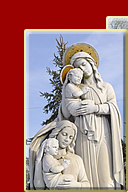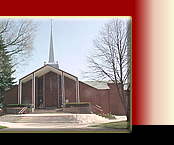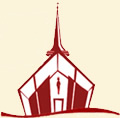
 |
|
||||
|
|||||
|
 His Eminence Samuel Cardinal Stritch presided over the dedication |
Groundbreaking took place in February of 1952   |
Church
 Father William Murphy asked the Chancery to grant approval to build St. Mary’s Mission Church, which eventually would become a parish church.
Father William Murphy asked the Chancery to grant approval to build St. Mary’s Mission Church, which eventually would become a parish church.
Samuel Cardinal Stritch dedicated the new colonial style Catholic Church to our Blessed Mother on June 28, 1953. This style of architecture was selected to integrate the structure with the peaceful town landscape. The front doors are made of redwood. Above those doors the Blessed Mother overlooks the portico. This statue is sculpted of white marble. Four rectangular pillars frame the façade. The steeple is constructed of aluminum. An electric carillon controls the bells and musical repertoire, resounding throughout town.
The critic of the Tribune praised the choice of exterior brick and interior wood colors as glowing in the earthly sphere and holy in the heavenly sphere, to paraphrase the article.
Our attention is drawn to the central feature of the church when entering-the linden wood crucifix, designed by E. J. Belli and hand carved in Italy. The crucifix portrays to the greatest extent imaginable the distress and torment suffered by our dying Savior. Below the crucifix is the single altar, simple in detail, completed in wood and built by the Cathedral Craftsmen of Waukesha, Wisconsin. Originally, only one statue was intended to be placed in the sanctuary, the hand-carved statue of the Holy Family Group. At the perimeter of the sanctuary stands the communion rail, which is deliberately made with no excess ornamentation or posts to allow worshipers an unobstructed vista of the altar.
In addition to the crucifix, the glistening black Belgium marble slabs representing the Stations of the Cross were also produced in Italy. They are made of bronze with a gold highlight. The emphasis in the choice of materials is the finish so that the Stations would blend with the background gently rather than stand out prominently from the wall.
 One of the Stations of the Cross |
 The original Baptistery in the vestibule of Church |
The choir loft includes a Wurlitzer Electronic Organ. The baptistery is to the right of the front entrance and is separated by an ornamental iron grille. A dual system provides heat employing radiant heat and high temperature convectors.
Lay people became more actively involved in ministries after Vatican Council II. The church was renovated. The Altar of Sacrifice was designed and built by Rev. Francis T. Menarik. The silver tabernacle is placed on an altar containing reliquaries of all the saints, apostles, and evangelists whose names are cited in the first Eucharistic Prayer of the Mass.
Construction of the Parish Rectory concluded on December 6, 1953. The Baltis Construction Company designed the residence.
In the Beginning...
|
The preceding paragraphs were derived from The Master Christi Dedication Book and A History of the Parishes of The Archdiocese of Chicago (1980, Vol 1).
 The original altar of Mater Christi Church |
 The altar after Vatican II |
 The altar as it is today |
 On this attar, rests the Blessed Sacrament within the Tabernacle |

Please feel free to contact the rectory for any question you may have at 708-442-5611 and 708-442-5612
“Let us not grow weary of doing good.” (Galatians 6:9)
© 2006 Mater Christi Parish - All Rights Reserved

 HIS EMINENCE, the Cardinal, in the blessing of the Church which will begin with the prayer, "O Lord God Who although Thou art unable to be encompassed by heaven and earth, art willing to have a home on earth where Your name name may be invoked" expressed perfectly our hopes and prayers for this church. It is the wish and expectation of your priests that this church may be the place of your invocation of God, the source of unlimited blessings and graces and God's home among yours. Since God now is in a special way one of your graces and God's home among yours. Since God now is in a special way one of your neighbors, we hope His presence among you will be a source of greater knowledge and love.
HIS EMINENCE, the Cardinal, in the blessing of the Church which will begin with the prayer, "O Lord God Who although Thou art unable to be encompassed by heaven and earth, art willing to have a home on earth where Your name name may be invoked" expressed perfectly our hopes and prayers for this church. It is the wish and expectation of your priests that this church may be the place of your invocation of God, the source of unlimited blessings and graces and God's home among yours. Since God now is in a special way one of your graces and God's home among yours. Since God now is in a special way one of your neighbors, we hope His presence among you will be a source of greater knowledge and love.